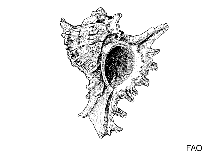Rapana venosa (Valenciennes, 1846)
Purple whelk| Native range | All suitable habitat | Point map | Year 2050 |

|
| This map was computer-generated and has not yet been reviewed. |
| Rapana venosa AquaMaps Data sources: GBIF OBIS |
Upload your photos
Google image | No image available for this species;
drawing shows typical species in Muricidae.
Google image | No image available for this species;
drawing shows typical species in Muricidae.
Classification / Names Common names | Synonyms | CoL | ITIS | WoRMS
Gastropoda | Neogastropoda | Muricidae
Environment: milieu / climate zone / depth range / distribution range Ecology
Benthic; brackish; depth range 10 - 60 m (Ref. 83435). Tropical; 4°C - 35°C (Ref. 88058); 41°N - 16°N, 53°E - 143°E
Distribution Countries | FAO areas | Ecosystems | Occurrences | Introductions
Indo-West Pacific. Introduced in the Atlantic, the Mediterranean and Black Sea.
Length at first maturity / Size / Weight / Age
Maturity: Lm ? range ? - ? cm Max length : 16.1 cm SHH male/unsexed; (Ref. 83435)
Short description Morphology
The species has a short-spired, heavy shell with a large inflated deep body whorl and deep umbilicus. The columella is broad, smooth, and slightly concave. Small and elongated teeth are present along the edge of the outer lip of the large ovate aperture. The external shell ornamentation has smooth spiral ribs that end in regular blunt knobs at both the shoulder and the periphery of the body whorl. In addition, fine spiral ridges are crossed by low vertical riblets. Body color is variable from gray to orange-brown and rarely blonde, with darker brown dashes on the spiral ribs. The aperture and columella vary from deep orange to yellow or off-white. Spiral, vein-like coloration, varying from black to dark blue, occasionally occurs internally, originating at the individual teeth at the outer lip of the aperture.
A large, predatory gastropod (Ref. 87893). The juvenile and adult stage of this species are preyed upon by loggerhead sea turtles (Caretta caretta) (Ref. 87893). Larvae are dispersed with water currents (Ref. 87977). This gastropod is a successful invader of marine coastal/brackish ecosystems , being tolerant to wide variations in temperature, salinity and oxygen concentration (Ref. 87992, 87996). Rapa whelks are generally encountered in areas to depths of 30 m in the Black Sea; on sandy bottoms at 15 m covered by Zostera sp. and Cymodocea nodosa meadows (Ref. 7956). Also occurs in rocky and muddy habitat (Ref. 87909). Feeds on bivalves (Ref. 87979).
Life cycle and mating behavior Maturity | Reproduction | Spawning | Eggs | Fecundity | Larvae
This species is a non-broadcast spawner. Life cycle does not include trocophore stage. Also Ref. 833.
Main reference
References | Coordinator | Collaborators
Tan, K.S. 2000. (Ref. 81755)
IUCN Red List Status
(Ref. 130435: Version 2024-2)
CITES status (Ref. 108899)
Not Evaluated
CMS (Ref. 116361)
Not Evaluated
Threat to humans
Harmless
Human uses
Fisheries: commercial
| FishSource | Sea Around Us
Tools
More information
Trophic Ecology
Ecology
Population dynamics
Growth
Max. ages / sizes
Length-weight rel.
Length-length rel.
Length-frequencies
Mass conversion
Recruitment
Abundance
Max. ages / sizes
Length-weight rel.
Length-length rel.
Length-frequencies
Mass conversion
Recruitment
Abundance
Life cycle
Human Related
Aquaculture profiles
Stamps, coins, misc.
Stamps, coins, misc.
Outreach
References
Internet sources
BHL | BOLD Systems | CISTI | DiscoverLife | FAO(Publication : search) | Fishipedia | GenBank (genome, nucleotide) | GloBI | Gomexsi | Google Books | Google Scholar | Google | PubMed | Tree of Life | Wikipedia (Go, Search) | Zoological Record
Estimates based on models
Preferred temperature
(Ref. 115969): 14 - 28, mean 25 (based on 570 cells).
Prior r = 0.78, 95% CL = 0.51 - 1.17, Based on 1 full stock assessment.
Nutrients : Calcium = 126 [75, 177] mg/100g; Iron = 4.79 [1.67, 7.92] mg/100g; Protein = 15.9 [14.8, 16.9] %; Omega3 = 0.331 [0.263, 0.400] g/100g; Selenium = 57.8 [48.5, 67.2] μg/100g; VitaminA = 0 μg/100g; Zinc = 1.97 [0.92, 3.02] mg/100g (wet weight); based on nutrient studies.



